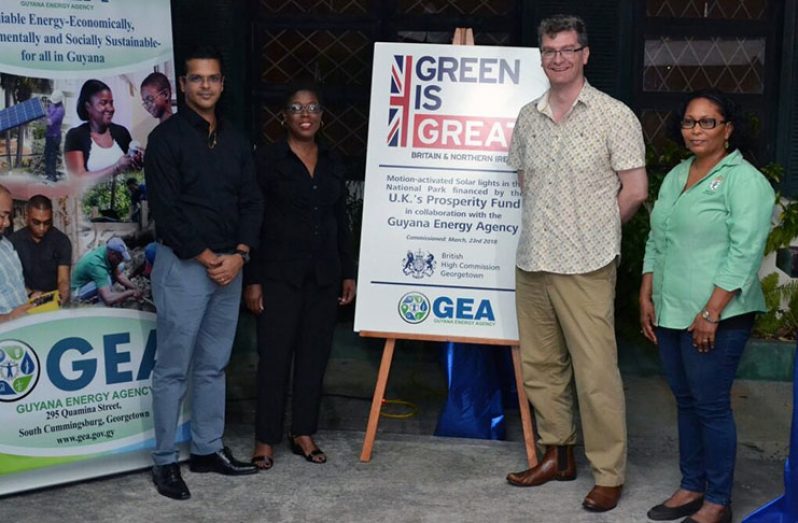THE Guyana Energy Agency (GEA) has installed 45 integrated stand-alone solar- powered 80W Light Emitted Diode (LED) street lights at the Guyana National Park.
The move is in keeping with GEA’s mandate to carry out research into all sources of energy, including those sources presently used in Guyana for the generation of energy, and securing more efficient utilisation of energy and sources of energy.
GEA’s Energy Engineer Brian Constantine, who monitored installation of the lights, explained that the project was financed by the British High Commission in Georgetown, through the UK’s Prosperity Fund, at a total cost of G$8,158,288.
He further explained that the supply and installation cost translates into a unit cost of $178,500 per light.
The project involved the replacement of inefficient mercury vapour lamps in the National Park, each rated at 250 watts, with the more energy-efficient 80-Watt solar-powered LED lights.
Prior to the installation, GEA had conducted the relevant evaluations as solar- powered street lights are not appropriate for deployment at all locations.
Locations for the use of solar-powered street lights have to be carefully reviewed to ensure that they are not shaded and have sufficient space on the existing poles to accommodate the structures.
Otherwise, separate poles have to be installed to accommodate the lights, which can add to the cost. In the case of this particular project, it was determined that the existing poles at the National Park would be utilized, as just minor modifications were needed to minimise the amount of shading on the surface of the module.
It is estimated that 49,275kWh of energy and 29,565kg of CO2 emissions annually will be avoided/saved through this investment. This translates to over G$2,800,000 yearly in savings in electricity costs. The simple payback on this investment is about four years.
Integrated solar-powered street lights use renewable energy from the sun to charge the batteries, which provide lighting at nights using energy-efficient LED lights.
The lights are controlled by a light-sensitive and timer-controlled circuit to switch the lights on in the evenings and turn them off at dawn.
As part of the energy-conservation features of the initiative, the technology dims the lights by 50 per cent when motion is not detected and returns to 100 per cent brightness when motion is detected.
One advantage of these systems is that they are not powered by the utility, thereby avoiding the use of fossil-based energy from the grid and the associated costs. Additionally, these lights are not affected by utility failures.
Dr Mahender Sharma, Chief Executive Officer of the Guyana Energy Agency expressed gratitude to British High Commissioner Greg Quinn and his staff for their support in making it possible to provide renewable energy and efficient lighting to the users of the National Park.
The CEO also thanked Denise Fraser, Commissioner, Protected Areas Commission and the staff of the National Park for the support throughout the project’s implementation.
Commenting on the project, High Commissioner Greg Quinn said: “It is incumbent on us all to do what we can to mitigate our impact on the environment and to improve energy efficiency. The High Commission therefore welcomed the opportunity to work with the GEA to install these lights.”
The GEA will continue to implement and spearhead such projects as part of the realisation of the agency’s objective to scale up solar power and other forms of renewable energy and energy-efficient technologies.



.jpg)








